Weeping Willow Trees: Leaves, Flowers (With Pictures) – Identification and Care Guide

The weeping willow is an easily recognizable tree with its graceful cascading branches, narrowly lanceolate leaves, and finger-like flower clusters. The most common weeping willow tree belongs to the genus Salix, and its botanical name is Salix babylonica. The medium- to large-sized, fast-growing weeping willow trees with their pendulous branches and stout grayish trunks thrive near waterways, ponds, and streams.
Most people can quickly identify a weeping willow in the landscape. Of all the types of trees with drooping branches, weeping willows are the most common.
If you have an expansive yard, weeping willows can make an excellent lawn or shade tree. The weeping trees are also incredibly easy to care for. However, there are several things you should know about planting and growing a weeping willow in a residential garden. In some cases, planting a dwarf weeping willow may be a better choice of tree for landscaping small front or backyards.
This article is a guide to identifying a weeping willow tree. Descriptions and pictures of weeping willow leaves, flowers, and bark will help recognize this beautiful tree. In addition, you will get helpful tips on how to plant a weeping willow tree and keep it healthy.
Weeping Willow Tree (Salix babylonica)
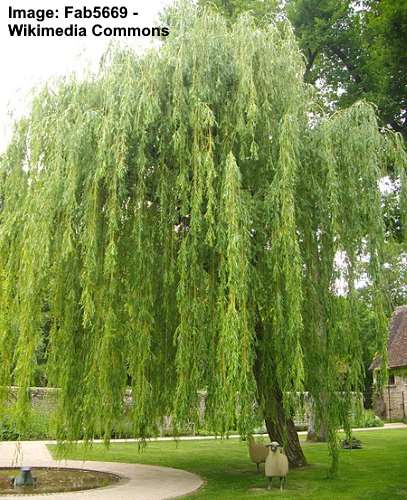
Weeping willow tree can be easily identified by its droopy branches
Weeping willow trees are native to China and belong to the genus Salix and the family Salicaceae. The beautiful deciduous trees grow 30 to 40 ft. (9 – 12 m) tall and wide. The water-loving tree has light, slender green, lance-shaped leaves, grayish-black bark, and clusters of flowers called catkins.
Weeping willow trees can be easily identified by their drooping branches. These pendulous branches gracefully cascade from the tree’s crown, almost reaching the ground. The large weeping willow tree also grows as wide as it is tall, giving it a broad, rounded crown.
Weeping willows are fast-growing trees and can grow about 10 ft. (3 m) per year until they reach their mature height of 40 ft. (12 m), but sometimes 50 ft. (15 m).
Weeping willows live for approximately 30 years, making them relatively short-lived deciduous trees.
The botanical name for weeping willow Salix babylonica comes from a misunderstanding that these weeping trees lined the Euphrates river in ancient Babylon. It was said that “by the rivers of Babylon,” the Jews sat down, wept, and hung their harps on the willows. However, these were poplar trees, not willows. Salix babylonica is also called the Babylon willow.
The USDA growing zone for weeping willows is 6 through 8. The weeping willow tree grows fastest in full sun and partial shade, getting four to six hours of sunlight daily. Like most types of willow trees, the weeping variety thrives in most soil types and moist ground. Therefore, you’ll often see the weeping willow tree growing on the banks of rivers and ponds.
How to Identify Weeping Willow Tree
The easiest way to identify a weeping willow tree in a landscape is by its rounded growth habit. The medium-sized tree has arching branches that sweep down to the ground. The pendulous branches are covered in linear leaves 6” (15 cm) long, and its bark is dark brown or gray-black.
Weeping Willow Leaves
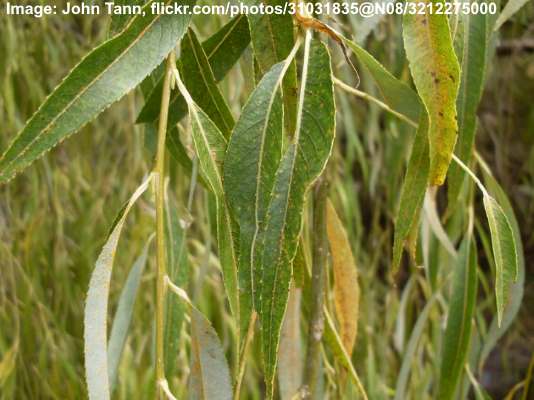
Weeping willow leaves
Leaves on a weeping willow tree are linear, lanceolate-shaped, growing in a simple, alternate arrangement. The slender leaves are light green above and glaucous or grayish-green underneath. Additionally, the smooth narrow tree leaves have serrated margins. Weeping willow leaves measure 3” to 6” (7.5 – 15 cm) long and 0.5” to 0.75” (1.3 – 1.9 cm) wide.
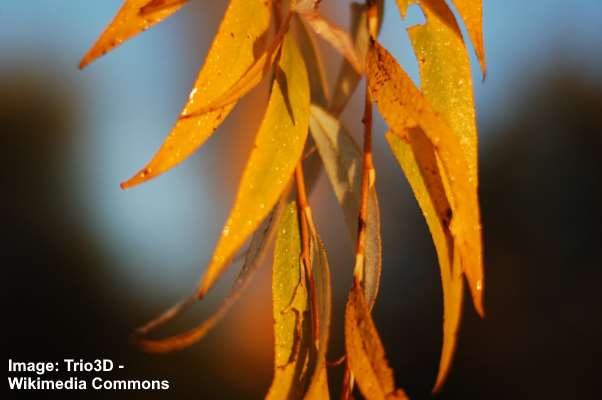
Weeping willow leaves in autumn
In the fall, weeping willow foliage turns a bright golden yellow to greenish-yellow color. After dropping from the tree, the bare reddish to yellowish-brown branches create a spectacular silhouette.
Weeping Willow Flowers

Weeping willow flower
Flowers on a weeping willow bloom in spring and are small, slender yellowish-green clusters called catkins. The dangling finger-like flower clusters measure 1” to 2” (2.5 – 5 cm) long. The insignificant petal-less weeping willow flowers stay on the drooping branches for several weeks.
Weeping willows are dioecious trees, meaning that male and female spring-blooming flower clusters grow on separate trees. The weeping willow male flowers tend to be the showiest thanks to the number of stamens on each catkin.
Weeping Willow Bark
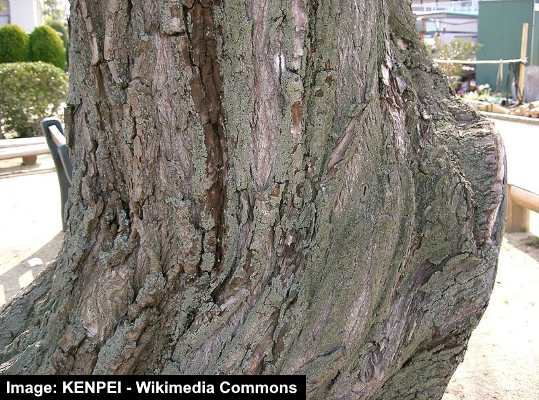
Weeping willow bark
Bark on a weeping willow tree is described as dark gray, dark brown, or almost black. The relatively thin dark-colored bark forms irregular, deep furrows. The long, deep ridges give the tree’s trunk a somewhat rough texture.
Like many species of willow, the weeping willow tree has branches, stems, and twigs in a reddish color. The drooping branches are reddish-brown or yellowish-brown and become more vibrant in the winter.
Dwarf Weeping Willow Tree (Salix caprea ‘Kilmarnock’)
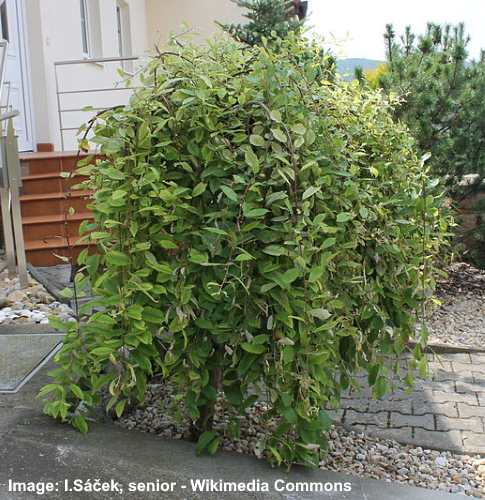
Dwarf Weeping Willow ‘Kilmarnock’ (Salix caprea ‘Kilmarnock’)
The dwarf weeping willow is a small ornamental tree with arching branches with a stiffly pendulous habit. The dwarf weeping tree grows 4 to 8 ft. (1.2 – 2.4 m) tall and 5 ft. (1.5 m) wide. Being a type of pussy weeping willow, the tree has fuzzy bud-like flowers and light green lanceolate leaves.
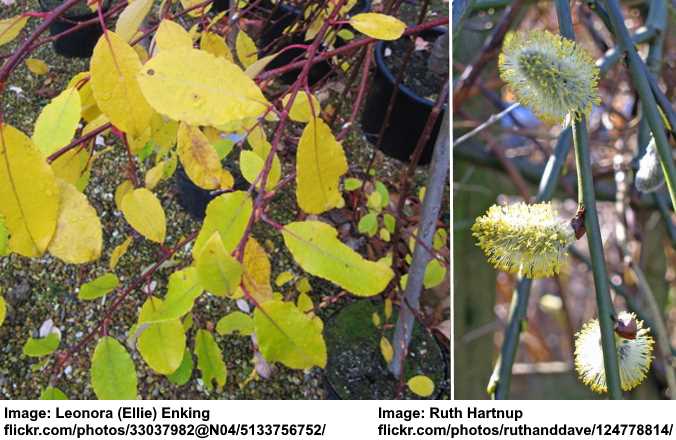
Dwarf Salix caprea ‘Kilmarnock’ leaves and flowers
Planting a dwarf weeping willow is ideal in compact garden landscapes. You can plant the decorative tree in rich, loamy, moist soil and full sun in USDA zones 4 through 8. However, because of its shrub-like growth, you will have to prune the tree to remove suckering stems that appear.
Types of Weeping Willow Trees
There are several types of weeping willow trees. They all have similar characteristics but differ slightly in their appearance. Some of them grow very tall while others are shorter. They have long branches with drooping leaves and weeping willow tree blooms during spring.
The most common type of weeping willow is the Salix babylonica variety. However, other weeping willow hybrids and cultivars have an equally elegant appearance.
Weeping Golden Willow (Salix × sepulcralis ‘Chrysocoma’)
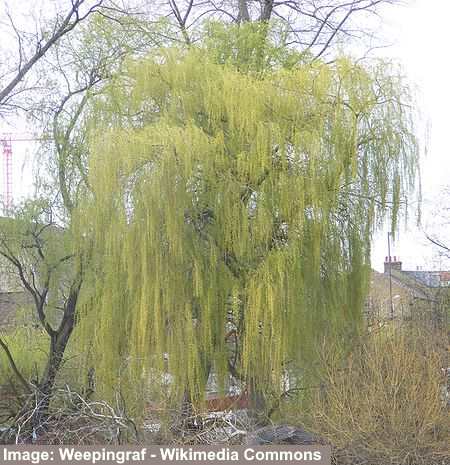
Weeping golden willow (Salix × sepulcralis ‘Chrysocoma’)
Weeping golden willow is a deciduous tree recognized by its golden yellow shoots, cascading habit, and deeply fissured grayish-brown bark. This weeping willow variety features narrow, glossy yellow-green lanceolate leaves that turn brilliant gold in the fall. The ‘Chrysocoma’ weeping willow cultivar grows 72 ft. (22 m) tall.
The weeping golden willow has a rounded, irregular crown and bright green foliage. The tree grows best near water sources when growing in full sun to partial shade. Grow the weeping golden willow in USDA zones 5 through 9.
White Weeping Willow (Salix alba ‘Tristis’)
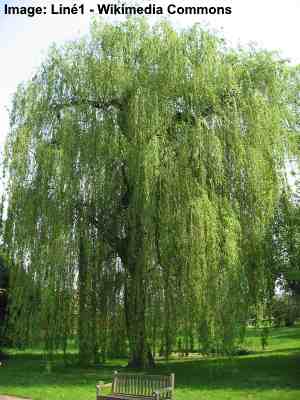
White weeping willow (salix alba ‘Tristis’)
The white weeping willow is a tall deciduous tree with bright green finely-toothed slender lanceolate leaves growing on drooping yellow branches. The weeping willow’s foliage turns golden yellow in the fall. The wispy, light foliage makes a stunning addition to landscapes as it gently sways in the wind.
The white weeping willow grows between 50 and 70 ft. (15 – 21 m) tall and wide. It’s ideal for planting near streams and ponds. However, due to its invasive and spreading roots, you shouldn’t plant it near buildings or sewer lines. White weeping willow thrives in USDA zones 4 through 8, grown in direct sunlight and medium to wet soils.
Wisconsin Weeping Willow (Salix x blanda and Salix x pendulina)

Wisconsin Weeping Willow (Salix x blanda and Salix x pendulina)
The Wisconsin weeping willows are beautiful trees that grow 20 to 40 ft. (6 – 12 m) tall. The graceful trees are identified by their drooping branches, covered in slender, lance-shaped leaves measuring 6” (15 cm) long. Additionally, fuzzy yellowish catkins bloom on yellowish-brown stems that sweep to the ground.
Also called the noble willow, the weeping willow with its pendulous branches thrives in moist ground near water sources. However, like all willow trees, you should avoid planting them too close to structures because of their invasive roots. It’s also good to note that the brittle stems of the Wisconsin weeping willow easily break in strong winds.
Where to Plant Weeping Willow
It’s best to plant weeping willows at least 50 ft. (15 m) from your house and underground utilities. Additionally, the roots grow close to the surface, meaning they can interfere with driveways and sidewalks.
Of course, if you have a large enough yard, weeping willows are a beautiful addition to a landscape. The weeping, graceful shape, tolerance of moist soils, and beautiful fall colors make weeping willows valuable ornamental trees. In addition, their extensive root system helps prevent soil erosion.
The most important consideration when planting a weeping willow is drainage and sun exposure. While a weeping willow can thrive in wet spots, it is not recommended to plant it in standing water. However, growing near a freshwater source is a good idea as the tree has heavy moisture requirements.
Here are some helpful tips on planting a weeping willow tree.
Weeping willow light requirements
Plant a weeping willow where it gets partial to full sunshine. Ideally, the decorative trees require at least two to four hours of unfiltered sun each day. However, they also thrive in full sun, meaning they can enjoy six to eight hours of direct sunlight each day.
Weeping willow tree soil
Plant the weeping willow in moist, well-drained, slightly acidic soil. However, the ornamental weeping trees tolerate several soil types, including loamy, sandy, clay, and alkaline. If you need to increase the soil acidity, you can use sulfur to amend the soil.
Weeping willow tree spacing
Weeping willows should be planted with enough space between them to allow the invasive root system space to grow. The roots of weeping willow trees can spread 30 to 45 ft. (9 – 14 m). Therefore, ensure trees grow at least 50 ft. (15 m) away from buildings.
Additionally, the trees can grow 40 to 50 ft. (12 to 15 m) tall in the space of a few years. Therefore, make sure the tree is planted well away from overhead power lines.
How to Plant a Weeping Willow Tree
To plant a weeping willow tree, dig a hole twice the width of the root ball and the same depth. This hole size will ensure that the roots have room to grow. Next, set the root ball in the middle of the hole, ensuring the trunk’s soil line is level with the ground.
The next step in planting a weeping willow tree involves backfilling the hole. First, fill the hole with native soil until it is halfway up the root ball. However, don’t tamp down the ground because you will prevent good drainage. Next, pour in 2 gallons (9 l) of water. Lastly, fill the hole to the top and press down the soil slightly.
Although weeping willows are somewhat tolerant of drought, they require regular watering during the first year. Therefore, water the tree’s root area once a week to ensure the ground is evenly moist. After the first year, you can water the tree less frequently.
Top tip when planting a weeping willow: Brown leaves could be a sign that the newly-planted tree lacks water. Therefore, increase the watering frequency to encourage healthy growth.
How to Care for Weeping Willow Tree
Weeping willow trees are relatively care-free. After the tree is established, you should water the tree enough to prevent the ground from going dry. Light pruning in early spring can help remove dead branches, and you can add a balanced fertilizer if the lanceolate leaves look pale.
Let’s look in more detail at how to care for a weeping willow tree.
How to water weeping willow tree
Weeping willows have moderate to high moisture requirements, especially in the first year or two. You may need to water a newly-planted weeping willow twice a week. However, once established, you can cut watering to once a week during dry weather. It would be best to water the tree as often as necessary to keep the soil moist.
Fertilizing weeping willow tree
Weeping willow trees usually don’t require additional fertilizer to grow healthy. However, pale foliage is a sign that the tree needs a nutrient boost. Therefore, you could apply a balanced fertilizer with an NPK ratio of 10-10-10 in the spring. Then, follow the manufacturer’s instructions and spread the tree fertilizer around the tree’s root area.
Pruning weeping willow tree
Pruning is necessary to help a young tree develop a central leader. Prune weeping willows in late winter or early spring and remove any branches growing in a deep ‘V’ shape at the tree’s base, as these are more likely to break. You can also lightly prune branches to encourage new growth and bushy foliage.
Weeping willow propagation
Take hardwood cuttings in late fall or winter to propagate a weeping willow tree. The cuttings should be 24” (60 cm) long with no green, soft tissue. To take a cutting, make a straight cut at the base of the stem, just below a bud. Then make a diagonal cut around 9” (23 cm) above the bud.
To grow a weeping willow from a cutting, place the straight end directly in the ground about 4” (10 cm) deep. Alternatively, you can start cuttings off in a pot of compost. Regardless of whether they grow in the ground or in a pot, keeping the soil evenly moist is vital. New shoots should develop in spring.
Weeping Willow Tree Problems
Weeping willow trees are prone to several problems. For example, their branches tend to be brittle and easily break in strong winds. Also, their invasive roots can become a problem for sewer lines and underground utilities. In addition, pests like aphids, willow leaf beetles, and bagworms can cause foliage loss.
Common pests affecting weeping willow tree growth
Here are some common pests known to cause willow tree problems:
Bagworms: These weeping willow pests are 2” (5 cm) long silk worms that live in tents that look like a collection of sticks hanging from tree branches. The caterpillars can defoliate trees.
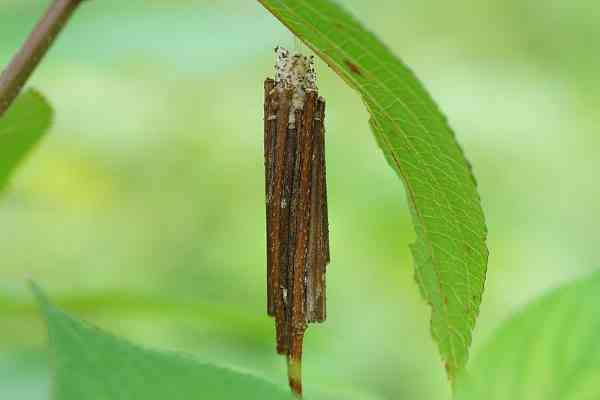
Bagworm moth larvae with the bag
Gypsy moth caterpillars: Active in June, the furry black and brown caterpillars feed on leaves during May and June. The caterpillars defoliate weeping willow trees and cause stunted growth.
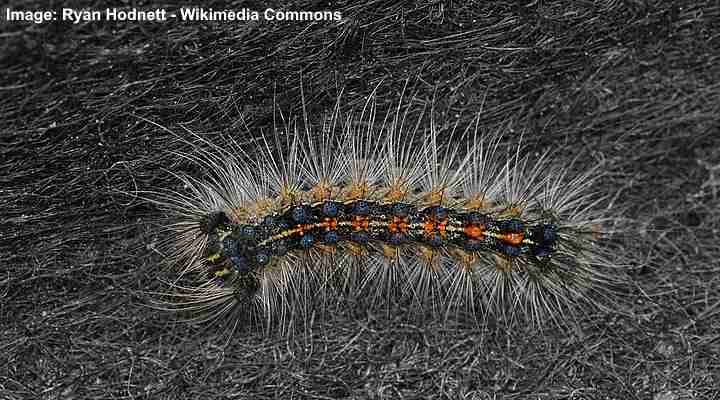
Gypsy moth (Lymantria dispar) caterpillar
Willow leaf beetles: The tiny metallic greenish-blue beetles gorge their way through willow leaves, skeletonizing them in the process. The beetles are a problem for weeping willow trees in late May.
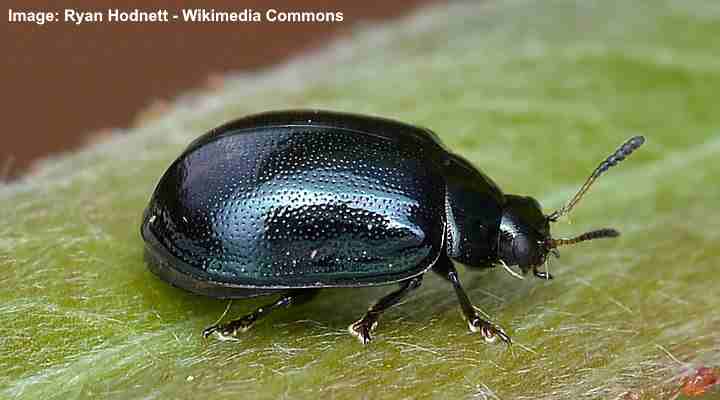
Willow leaf beetle (Plagiodera versicolora)
Common diseases affecting weeping willow tree growth
Unfortunately, several diseases can affect weeping willow trees. Problematic diseases for weeping willows include cankers, leaf spot, powdery mildew, willow scab, and crown gall. Signs of weeping willow diseases include blemishes on leaves, dieback, and even tree death.
The best way to prevent problems with a weeping willow tree is to keep the tree healthy. This means providing adequate water to avoid stressing the tree. In addition, it’s a good idea to eliminate leaf litter promptly to prevent tree diseases from spreading.
Discover many more types of willow trees and shrubs.
Related articles:
